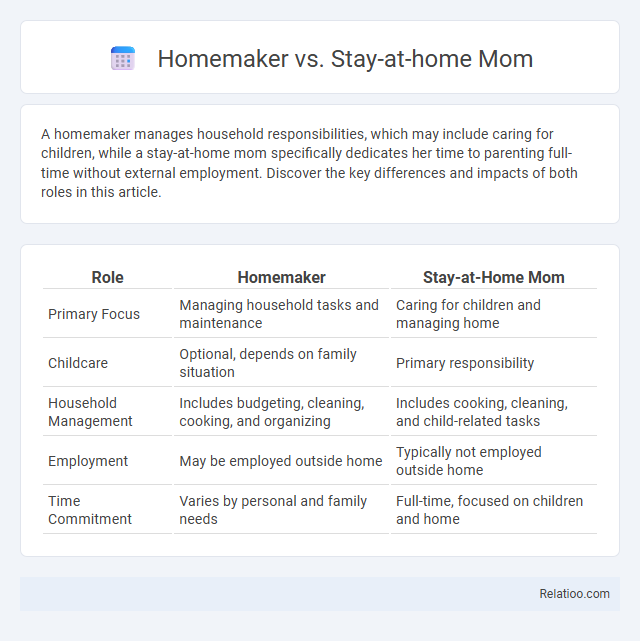A homemaker manages household responsibilities, which may include caring for children, while a stay-at-home mom specifically dedicates her time to parenting full-time without external employment. Discover the key differences and impacts of both roles in this article.
Table of Comparison
| Role | Homemaker | Stay-at-Home Mom |
|---|---|---|
| Primary Focus | Managing household tasks and maintenance | Caring for children and managing home |
| Childcare | Optional, depends on family situation | Primary responsibility |
| Household Management | Includes budgeting, cleaning, cooking, and organizing | Includes cooking, cleaning, and child-related tasks |
| Employment | May be employed outside home | Typically not employed outside home |
| Time Commitment | Varies by personal and family needs | Full-time, focused on children and home |
Defining Homemaker and Stay-at-Home Mom
A homemaker is an individual responsible for managing household tasks such as cleaning, cooking, and organizing, regardless of whether they receive financial compensation. A stay-at-home mom specifically refers to a mother who chooses to remain at home to care for her children full-time while managing domestic duties. Understanding these roles helps you appreciate the diverse ways household responsibilities are fulfilled beyond traditional employment.
Historical Context of Both Roles
The historical context of homemakers and stay-at-home moms reveals distinct yet overlapping roles shaped by social norms and economic shifts. Homemakers traditionally managed household duties and family welfare, often without formal employment, reflecting societal expectations from the 19th to mid-20th centuries. Stay-at-home moms emerged as a more specific designation in the post-World War II era, emphasizing child-rearing and domestic management during periods of increased female workforce participation and evolving family dynamics.
Key Responsibilities Compared
Homemakers primarily focus on managing household duties such as cleaning, cooking, and budgeting, ensuring a well-organized and functional home environment. Stay-at-home moms handle similar tasks but often include additional responsibilities related to childcare, education, and emotional support for their children throughout the day. While both roles prioritize domestic management, stay-at-home moms tend to have a dual focus on nurturing their children's development alongside maintaining the household.
Social Perceptions and Stereotypes
Social perceptions of homemakers, stay-at-home moms, and housewives often overlap but carry distinct stereotypes that impact how society values their roles. Homemakers are frequently seen as managing household tasks with a degree of autonomy, while stay-at-home moms are stereotyped as primary caregivers solely focused on childcare, sometimes facing assumptions of dependency or lack of ambition. These roles are often undervalued despite the emotional labor and organizational skills involved, highlighting ongoing gender biases and societal expectations about women's contributions both inside and outside the home.
Economic Contributions and Value
Stay-at-home moms and homemakers both contribute significantly to the economy through unpaid labor such as child care, housework, and managing household budgets, which would otherwise require paid services. Homemakers, whether or not they are mothers, create value by enabling family members to focus on income-generating work, thus indirectly supporting the financial stability of the household. Your choice to embrace any of these roles reflects the essential economic contributions that maintain and enhance the well-being of families and communities.
Impact on Personal Identity
Homemaker, stay-at-home mom, and homemaker roles each shape personal identity through societal expectations and self-perception differently. Your sense of purpose and fulfillment can evolve based on how you balance domestic responsibilities with personal goals and social connections. Embracing the unique aspects of each role fosters confidence and a well-rounded identity grounded in nurturing both family and self.
Challenges Unique to Each Role
Homemakers often face the challenge of balancing multiple household responsibilities without formal recognition or support, which can lead to feelings of isolation and undervaluation. Stay-at-home moms uniquely navigate the emotional and physical demands of full-time childcare while managing household tasks, often resulting in time constraints and limited personal space. Your ability to address these role-specific challenges depends on establishing a support network and setting personal boundaries to maintain well-being and effectiveness in each role.
Work-Life Balance Considerations
Homemakers and stay-at-home moms both prioritize nurturing family needs but differ in the scope of household management and personal fulfillment, impacting work-life balance uniquely. Stay-at-home moms often juggle full-time childcare with household duties, while homemakers may include paid or part-time work, requiring structured time management to maintain personal well-being. Balancing these roles demands tailored strategies to optimize mental health, productivity, and family dynamics.
Support Networks and Community
Support networks for homemakers, stay-at-home moms, and homemakers often differ in availability and focus, impacting your social well-being and mental health. Stay-at-home moms typically engage in parent-focused groups and playdates, while homemakers may connect through broader domestic interest communities or online forums. Building and maintaining these support systems empowers your daily responsibilities and enriches your social interactions.
Choosing the Right Path for Your Family
Choosing the right path for your family involves understanding the distinctions between a homemaker, a stay-at-home mom, and a hybrid role. A homemaker manages household responsibilities efficiently, regardless of external employment status, ensuring a nurturing and organized environment. A stay-at-home mom dedicates her time exclusively to child-rearing and home care, prioritizing familial bonding and child development, while a hybrid approach balances professional work with household duties to best meet individual family needs.

Infographic: Homemaker vs Stay-at-home Mom
 relatioo.com
relatioo.com